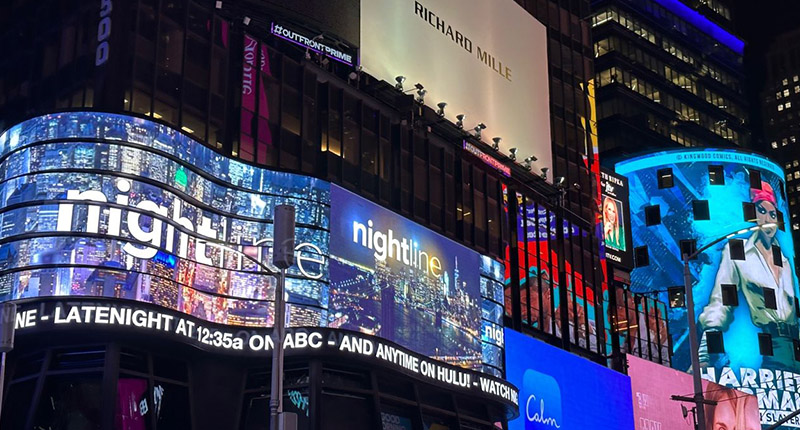If you’ve ever noticed an LED display that doesn’t look as bright as it used to, you’ve seen lumen decay in action. This is a normal, gradual reduction in brightness over time. The good news: while it can’t be completely avoided, you can slow it down dramatically with smart product choices, solid engineering, and proper maintenance. In this guide, we break down the science in plain English and give you practical steps to extend the life and visual quality of your LED screens.
What Is LED Display Lumen Decay?
LED display lumen decay is the irreversible drop in brightness as an LED ages. It happens because the core components inside each LED package slowly degrade with use, heat, and environmental stress. Key parts affected include:
- LED chip (the semiconductor that emits light)
- Phosphor (converts blue or UV light to white or other colors)
- Encapsulation material (silicone or epoxy that protects the chip)
- Lead frame/bracket and interconnects (mechanical and electrical support)
Over thousands of hours, these materials experience chemical and physical changes that make the LED emit less light—even if it’s still working electrically.
How Do We Measure It? The L70 Standard
In the LED industry, “L70 lifetime” is the common benchmark. It answers a simple question: how many hours until the LED’s brightness drops to 70% of its original value? For quality LED displays, L70 can typically reach 50,000 to 100,000 hours, depending on product design, operating conditions, and maintenance. For context:
- 50,000 hours ≈ 5.7 years at 24/7 operation
- 100,000 hours ≈ 11.4 years at 24/7 operation Real-world lifetimes vary because few screens run at full brightness around the clock and environments differ widely.
What Drives Lumen Decay? Internal vs. External Factors
Internal (component-level) factors
- Chip lattice defects: Tiny imperfections in the semiconductor grow over time, turning light energy into heat instead of brightness.
- Phosphor oxidation: Moisture and heat can oxidize phosphor, reducing its efficiency and shifting color.
- Encapsulation yellowing: Some encapsulants (especially older epoxy types) yellow with heat and UV, absorbing light and lowering output.
- Bracket corrosion: Corrosion at the lead frame or bond points increases resistance and heat, accelerating decay.
External (environmental and operational) factors
- Temperature (the biggest lever): As a rule of thumb, every 10°C rise can double the rate of lumen decay. High junction temperature is enemy number one.
- High humidity: Moisture accelerates corrosion and phosphor degradation, especially in coastal or tropical climates.
- Overdrive current: Pushing LEDs above rated current boosts short-term brightness but dramatically speeds up aging.
- UV exposure: Sunlight or UV sources can break down encapsulants and surface coatings, causing yellowing and performance loss.
- Dust buildup: Dust insulates heat sinks and optics, raising temperature and scattering light, which makes the screen appear dimmer.
A Practical Playbook to Reduce Lumen Decay
Smart product selection
- Prefer high-quality chip platforms: They typically offer better thermal stability and lower defect growth over time.
- Choose silicone-encapsulated LEDs: Silicone resists yellowing and UV damage far better than conventional epoxy.
- Use constant-current drivers: Stable current reduces thermal spikes and prevents overstress that accelerates aging.
Design and engineering best practices
- Strengthen thermal management: Larger heat sinks, high-conductivity PCBs (e.g., aluminum or copper substrates), efficient cabinet ventilation, and intelligent fan control all keep junction temperatures in check.
- Improve ingress protection: For humid, dusty, or semi-outdoor sites, target higher IP ratings, conformal coatings, and sealed cable paths to block moisture and contaminants.
- Optimize pixel driving: Calibrate brightness curves, implement derating at high ambient temperatures, and avoid unnecessary overdrive in bright environments.
Operations and maintenance tips
- Avoid running at 100% brightness for long periods: Most applications look great at 40–70% brightness, especially indoors. This step alone can extend life significantly.
- Clean the display regularly: Gentle, non-abrasive cleaning removes dust that traps heat and dulls perceived brightness. Follow the manufacturer’s cleaning guidelines.
- Inspect power and cooling systems: Periodically check fans, filters, power supplies, and temperature sensors. Replace failing components early to prevent heat-related damage.
Key Takeaways
- Lumen decay is inevitable—but manageable. Think of it like tire wear: your driving style and conditions make a big difference.
- Heat is the main culprit. Control junction temperature with better components, thermal design, and sensible brightness settings.
- Quality parts pay off. Chips with stable substrates, silicone encapsulation, and constant-current drivers offer a longer, steadier life.
- Maintenance matters. Keep it clean, keep it cool, and check your power and fans.
Conclusie
LED display lumen decay can’t be eliminated, but you can meaningfully slow it down. Start with high-quality components, design for heat and moisture control, operate below maximum brightness when possible, and keep your system clean and well-maintained. Follow this formula and you’ll extend both the useful life and the visual punch of your LED screen—delivering better performance and lower total cost of ownership year after year.
Veelgestelde vragen
- Does lumen decay mean my LEDs are failing?
Not necessarily. Lumen decay is normal aging. The LEDs can still function electrically but will emit less light over time. - What’s a good L70 number for LED displays?
For professional-grade displays, 50,000–100,000 hours is a strong benchmark. Your actual results depend on ambient temperature, duty cycle, and maintenance. - Can software calibration fix lumen decay?
Calibration can balance color and uniformity as modules age, but it can’t restore lost intrinsic brightness. It’s a useful tool, not a cure. - Indoor vs. outdoor—who decays faster?
Outdoor displays face heat, UV, moisture, and dust, so they typically age faster. Robust thermal design and higher IP ratings are essential outdoors. - Will lower brightness settings improve lifetime?
Yes. Reducing drive current cuts heat and slows chemical degradation, extending both brightness and color stability over time.
If you would like to know more information and pricing, please contact us!



